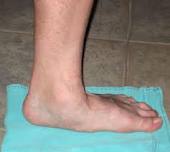

When symptoms do occur, patients typically experience the following: In some individuals, flat feet may not cause any symptoms or problems. Previous injury or surgery of the posterior tibial tendon.People who run frequently and those involved in high-impact sports like basketball, tennis or soccer are therefore at a higher risk for PTTD. This wear-and-tear of the tendon tends to occur gradually over time from participating in too many activities that strain the feet. There are many factors that can contribute to PTTD, but it usually develops from overusing the posterior tibial tendon. PTTD only occurs in adults and it affects females about four times as frequently as males, which is why it's most common in women between the ages of 40-60. When this tendon gets damaged for any reason and the arch of the foot flattens, it results in PTTD. This tendon helps maintain the arches and normal alignment of your foot, and provides support so you can walk normally. The posterior tibial tendon begins at one of the smaller muscles of the calf, runs through the middle of the ankle, and connects to the bottom of the foot.

This leads to the flattening of one foot-or sometimes both feet-with lower arches. Adult-acquired flatfoot, also known as fallen arches or posterior tibial tendon dysfunction (PTTD), is a painful condition that occurs when this tendon becomes inflamed, overstretched or torn. The posterior tibial tendon, which stretches from the calf to the bones in the middle of your foot, is one of the most important tendons in the lower leg. Laser therapy is completely safe, as well as non-invasive and painless.Adult-Acquired Flatfoot (Posterior Tibial Tendon Dysfunction) Pain relief can often be felt after the first session. MLS Class IV Laser Therapy reduces pain because it addresses the cause of that pain, whether this is by healing, repair or regeneration. Furthermore, long-term pain relieving medication only helps to deal with the symptoms, and not the underlying cause of the pain / condition. It is not always best to rely on pain medications, due to their side effects. However, for many patients, the above condition can leave them crippled and unable to carry out daily activities. The assessment will provide an accurate diagnosis, allowing the Podiatrist to prepare a suitable treatment plan, which may include recommended stretches, custom made orthotics, and footwear advice. Due to this, a condition cannot be solved simply by consultation, and a thorough hands-on assessment is required.īy carrying out a Biomechanical Gait Analysis Assessment, the Podiatrist will consider your foot condition, but also take into account symptoms being experienced further up the skeleton. Therefore, any problems within the the lower back, thigh muscles, knee joints, and lower limbs will contribute to your foot pain. Your feet are placed at the bottom of the skeleton tree. Flat Feet Treatmentsĭue to the feet being a complex part of your body, they can not be, and should not be, looked at in isolation. Patients with flat feet may experience arch pain, shin splints, knee pain, hip pain, and lower back pain. However, if your flat foot is causing you pain then it is time to seek some treatment and advice. Having flat feet is not consider a major problem if you are not in pain. Having an arch is important for pressure distribution. This is also referred to as a dropped or fallen arch. Therefore, when standing, the whole foot (ball, arch and heel) will be in complete or near-complete contact with the ground. Flat foot is where there is no visible arch seen in the foot when you stand.


 0 kommentar(er)
0 kommentar(er)
